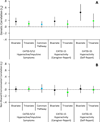Childhood attention-deficit/hyperactivity disorder symptoms and the development of adolescent alcohol problems: A prospective, population-based study of Swedish twins
- PMID: 26714985
- PMCID: PMC5300044
- DOI: 10.1002/ajmg.b.32412
Childhood attention-deficit/hyperactivity disorder symptoms and the development of adolescent alcohol problems: A prospective, population-based study of Swedish twins
Abstract
Children with attention-deficit/hyperactivity disorder (ADHD) are at increased risk of problematic alcohol and other substance use in adolescence. This study used data from an ongoing, prospective, population-based twin study of Swedish children and adolescents to evaluate the extent to which the association between ADHD symptoms and alcohol problems reflects a unique source of genetic or environmental risk related to ADHD versus a broader predisposition to youth externalizing behavior. We used all available data from same-sex monozygotic (MZ) and dizygotic (DZ) twins on ADHD symptoms in childhood (age 9/12; N = 15,549) and alcohol problems in late adolescence (age 18; N = 2,564). Consistent with prior longitudinal studies, the phenotypic association between hyperactive/impulsive ADHD symptoms and alcohol problems was small in magnitude, whereas the association for inattentive symptoms was even weaker. Additive genetic influences explained 99.8% of the association between hyperactive/impulsive symptoms and alcohol problems. Furthermore, we found that the genetic risk specifically associated with hyperactive/impulsive symptoms was attenuated when estimated in the context of externalizing behavior liability during childhood, of which ADHD symptoms were specific expressions. In sensitivity analyses exploring hyperactivity in mid-adolescence, we found a similar pattern of genetic associations. These results are consistent with previous findings of genetically driven overlap in the etiology of ADHD and problematic alcohol use. At least some of this co-occurrence may result from a general predisposition to externalizing behaviors in youth. © 2015 Wiley Periodicals, Inc.
Keywords: ADHD; behavioral genetics; externalizing; neurodevelopmental problems; substance misuse.
© 2015 Wiley Periodicals, Inc.
Conflict of interest statement
Henrik Larsson has served as a speaker for Eli-Lilly and Shire and has received a research grant from Shire, all outside the submitted work.
Figures



Similar articles
-
Associations between childhood ADHD, gender, and adolescent alcohol and marijuana involvement: A causally informative design.Drug Alcohol Depend. 2018 Mar 1;184:33-41. doi: 10.1016/j.drugalcdep.2017.11.011. Epub 2017 Dec 27. Drug Alcohol Depend. 2018. PMID: 29402677 Free PMC article.
-
Genetic and environmental influences on adult attention deficit hyperactivity disorder symptoms: a large Swedish population-based study of twins.Psychol Med. 2013 Jan;43(1):197-207. doi: 10.1017/S0033291712001067. Epub 2012 Aug 16. Psychol Med. 2013. PMID: 22894944
-
Twin study of the relationship between adolescent attention-deficit/hyperactivity disorder and adult alcohol dependence.J Stud Alcohol Drugs. 2012 Mar;73(2):185-94. doi: 10.15288/jsad.2012.73.185. J Stud Alcohol Drugs. 2012. PMID: 22333326 Free PMC article.
-
The nature and nurture of ADHD and its comorbidities: A narrative review on twin studies.Neurosci Biobehav Rev. 2020 Feb;109:63-77. doi: 10.1016/j.neubiorev.2019.12.017. Epub 2019 Dec 12. Neurosci Biobehav Rev. 2020. PMID: 31838192 Review.
-
[How does maternal alcohol consumption during pregnancy affect the development of attention deficit/hyperactivity syndrome in the child].Fortschr Neurol Psychiatr. 2011 Sep;79(9):500-6. doi: 10.1055/s-0031-1273360. Epub 2011 Jul 7. Fortschr Neurol Psychiatr. 2011. PMID: 21739408 Review. German.
Cited by
-
Intergenerational transmission of genetic risk for hyperactivity and inattention. Direct genetic transmission or genetic nurture?JCPP Adv. 2024 Mar 4;4(2):e12222. doi: 10.1002/jcv2.12222. eCollection 2024 Jun. JCPP Adv. 2024. PMID: 38827976 Free PMC article.
-
Reward-related ventral striatum activity links polygenic risk for attention-deficit/hyperactivity disorder to problematic alcohol use in young adulthood.Biol Psychiatry Cogn Neurosci Neuroimaging. 2017 Mar;2(2):180-187. doi: 10.1016/j.bpsc.2016.10.003. Biol Psychiatry Cogn Neurosci Neuroimaging. 2017. PMID: 28825048 Free PMC article.
-
The association between general childhood psychopathology and adolescent suicide attempt and self-harm: A prospective, population-based twin study.J Abnorm Psychol. 2020 May;129(4):364-375. doi: 10.1037/abn0000512. Epub 2020 Apr 9. J Abnorm Psychol. 2020. PMID: 32271026 Free PMC article.
-
Early substance use in the pathway from childhood attention-deficit/hyperactivity disorder (ADHD) to young adult substance use: Evidence of statistical mediation and substance specificity.Psychol Addict Behav. 2020 Mar;34(2):281-292. doi: 10.1037/adb0000542. Epub 2019 Dec 30. Psychol Addict Behav. 2020. PMID: 31886682 Free PMC article.
-
Executive Function as an Underlying Mechanism of Alcohol Use, Aggression, and ADHD.medRxiv [Preprint]. 2024 Jun 11:2024.06.10.24308620. doi: 10.1101/2024.06.10.24308620. medRxiv. 2024. PMID: 38946945 Free PMC article. Preprint.
References
-
- American Psychiatric Association. Diagnostic and statistical manual of mental disorders. Washington, DC: Author; 1994.
-
- American Psychiatric Association. Diagnostic and statistical manual of mental disorders, Fifth edition. Arlington, VA: American Psychiatric Association; 2013.
-
- Anckarsäter H, Lundström S, Kollberg L, Kerekes N, Palm C, Carlström E, Långström N, Magnusson PKE, Halldner L, Bölte S, Gillberg C, Gumpert C, Råstam M, Lichtenstein P. The Child and Adolescent Twin Study in Sweden (CATSS) Twin Res Hum Genet. 2011;14(06):495–508. - PubMed
-
- Babor TF, Higgins-Biddle JC, Saunders JB, Monteiro MG. The Alcohol Use Disorders Identification Test: Guidelines for use in primary care. Geneva, Switzerland: World Health Organisation; 2001.
Publication types
MeSH terms
Grants and funding
LinkOut - more resources
Full Text Sources
Other Literature Sources
Medical

